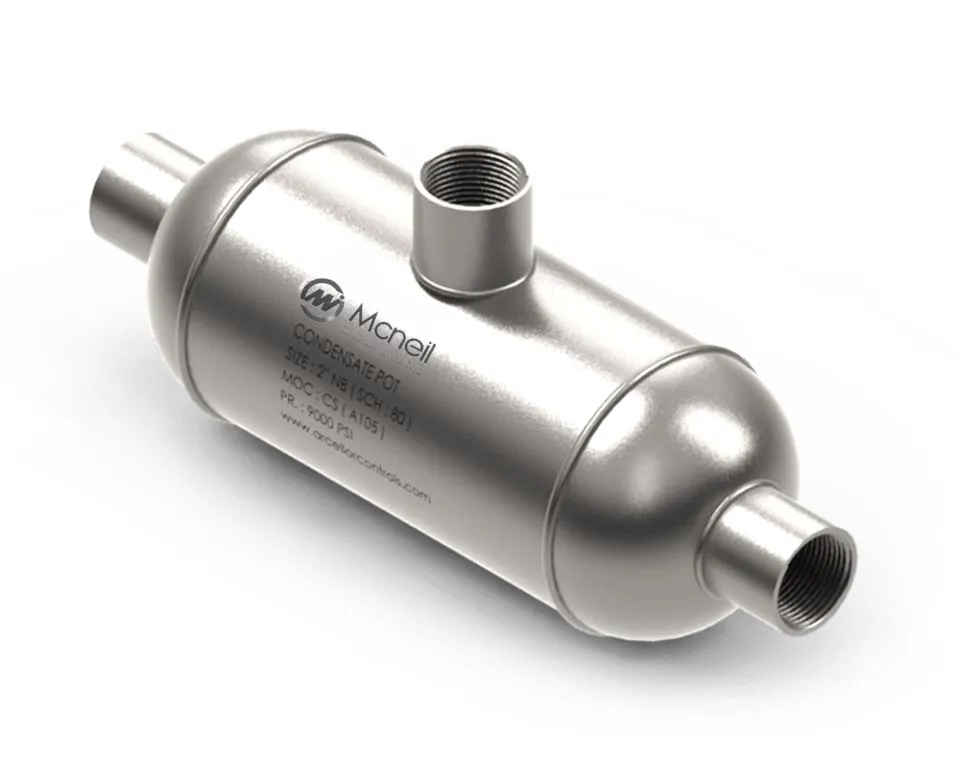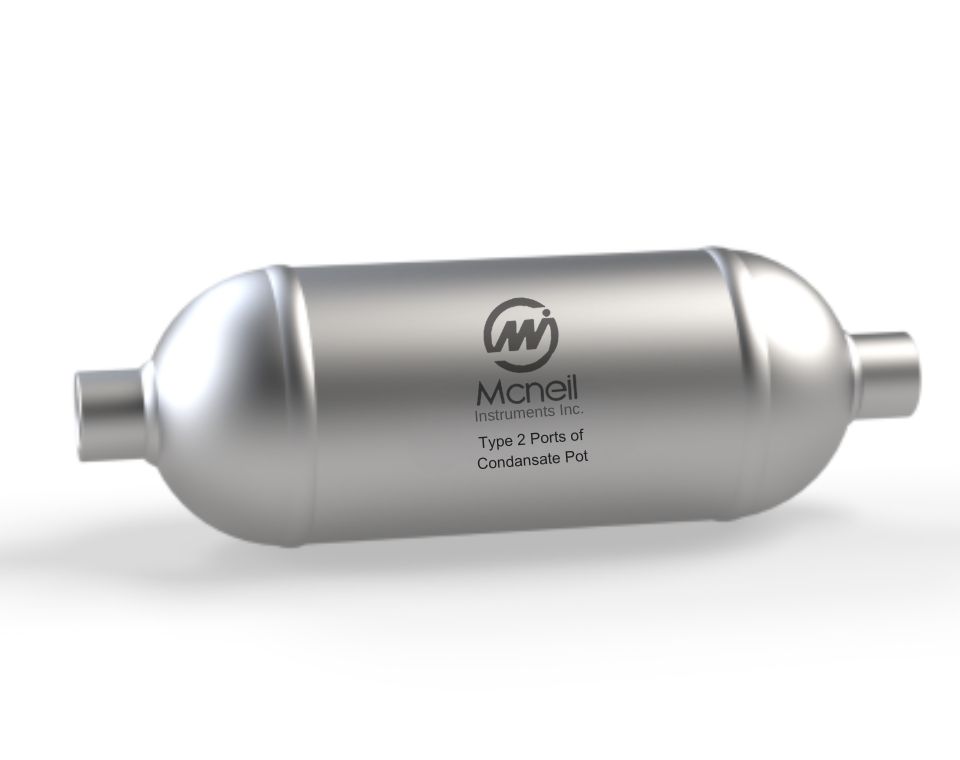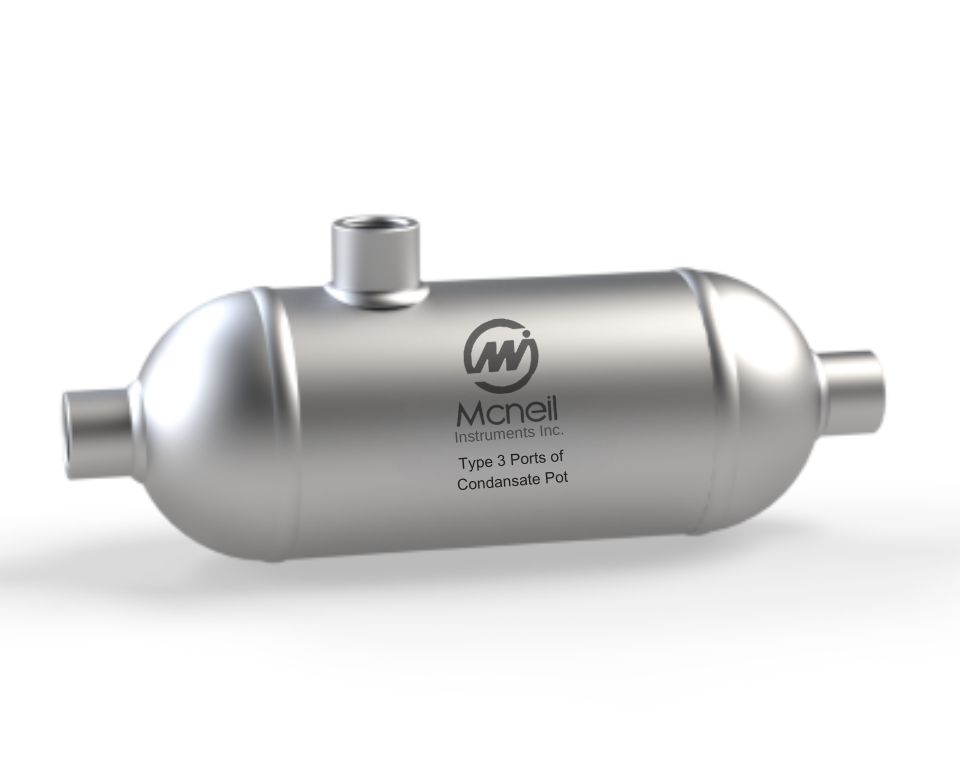Best Condensate Pot Manufacturer in India
Mcneil Instruments is a leading condensate pot manufacturer,supplier and exporter to various countries globally. The condensate pots are made from superior quality materials and sold at competitive rates.
The prime purpose of a Condensate seal Pot is to hold foreign material and any liquid resulting from vapour (condensate). This avoids the metering system from being damaged. Condensate pot has a pipe with a 4 inch diameter which is fixed horizontally between the flow meter and gauge. It is employed as a blockade between the chief line and the secondary mechanism to measure steam or any other vapours which may turn into liquid state in order to ensure compatibility with the secondary apparatus.

Mcneil Instruments is also a leading IBR condensate pot manufacturer, supplier, and exporter catering to various countries globally. These IBR condensate pots are crafted from superior-quality materials and offered at competitive rates to meet diverse industrial requirements.
We provide a wide range of inexpensive CONDENSATE POT. There is a capture and storage of condensate. As a result, the numerous orifices stay clean and clutter-free. They are upstream from the instrument, and a bottom drain makes cleaning possible. The condensate pots can be made of a variety of materials. The primary purpose of a condensate or seal pot is to hold both foreign items and any liquid that condenses from vapor. This guards against metering system damage.
Between the flow meter and gauge, a horizontal 4-inch diameter pipe leads to the condensate pot. It acts as a blocker between the primary line and the secondary mechanism to measure steam or any other vapors that may transition into a liquid state in order to assure compatibility with the secondary apparatus. To lessen the chance of error caused by an unequal fluid head in the associated pressure lines, units should be spaced uniformly.
We provide a wide range of affordable IBR condensate pots, designed to capture and store condensate effectively, the IBR condensate pots are essential for holding foreign particles and any liquid condensate, ensuring the metering system remains protected from damage.
Types Of Condensate Seal Pot

Condensate Pot Type Two Ports
Mcneil Instruments Inc. Two Ports Condensate Pots Manufacturer, Supplier, & Exporter in India.

Condensate Pot Type Three Ports
Mcneil Instruments Inc. Three Ports Condensate Pots Manufacturer, Supplier, & Exporter in India.
Condensate Pot Type Four Ports
Mcneil Instruments Inc. Four Ports Condensate Pots Manufacturer, Supplier, & Exporter in India.
The Condensate Pot Working Principle is based on the presence of steam vapor between the process tapping and the pot. The water between the pot and the differential pressure transmitter eliminates potential errors that may arise in a Condensate Seal Pot due to liquid mixing at the measurement device. Each impulse line requires one Condensation Pot. To accurately sense fluid flow conditions, these Steam Condensate Pots are installed either vertically or horizontally. The Condensate Pot Design ensures the unit is positioned at the same level as the pipe, which helps minimize any errors caused by unequal fluid levels.
Condensate Pots for Pressure Transmitters need heat tracing, and impulse lines must be insulated. Antifreeze media, such as glycol, can be added to the water lines. The Condensate Pot Parker is ideally designed to trap any foreign material, preventing damage to the pipeline. The Steam Condensate Pot Working Principle also suggests that the impulse line from the condenser pot to the DP transmitter should have blowdown capabilities. Mcneil supplies Parker Condensate Pots to various industries. Condensate Pot Swagelok units are manufactured according to international standards and undergo several tests to confirm their properties.
Condensate Pot Manufacturer, Supplier, and Exporter
Mcneil Instruments Inc. is the top Manufacturer, Supplier, and Exporter of condensate pots in India. We provide a wide range of inexpensive CONDENSATE POT. There is a capture and storage of condensate. As a result, the numerous orifices stay clean and clutter-free. They are upstream from the instrument, and a bottom drain makes cleaning possible. The condensate pots can be made of a variety of materials. The primary purpose of a condensate or seal pot is to hold both foreign items and any liquid that condenses from vapor. This guards against metering system damage.
Between the flow meter and gauge, a horizontal 4-inch diameter pipe leads to the condensate pot. It acts as a blocker between the primary line and the secondary mechanism to measure steam or any other vapors that may transition into a liquid state in order to assure compatibility with the secondary apparatus. To lessen the chance of error caused by an unequal fluid head in the associated pressure lines, units should be spaced uniformly.
Selection Criteria:
- Pipe Size: Available in 2″, 3″, 4″, 5”, and 6″, with larger sizes on request.
- Pipe Schedule: Options include 40, 80, 160, and XX seamless pipes.
- Number of Ports: Configurations range from 2 to 8 ports, with arrangements provided in the reference section.
- Pipe Length: Standard lengths include 8″, 10″, and 12″, with extended lengths available upon request.
- Material of Construction: Choose from Carbon Steel (ASTM A106, ASTM A105), Stainless Steel (316, 304), Alloy Steel (ASTM A335 P11, P22, P91), Monel 400, and Hastelloy C276. See below for visual references.
- Thread Connections: NPT (ANSI B1.20.1), Socket Weld (ANSI B16.11), and Butt Weld (ANSI B16.9).
- Additional Options: Titanium Fittings and Titanium Ferrule Compression Fittings are also available.
How to Install a Condensate Pot
Installing a condensate pot is crucial for accurate flow measurement. Here’s a simplified guide to help you install it correctly, either on vertical or horizontal lines, between the primary (Flow Meter) and the secondary (transmitter/gauge). This setup acts as a barrier to the line fluid and allows direct sensing of flow conditions.
- Plan Connections: Before ordering, determine the number of connections you need (e.g., inlets, outlets, fill port, drain port, gas vent port).
- Determine Specifications: Define the volume of the condensate pot in liters. Consider the system’s pressure and temperature requirements.
- Heat and Insulation: Think about whether you need to heat trace and insulate all the impulse lines to prevent freezing or temperature drops.
- Anti-Freeze Media: You might need to add anti-freeze media, like glycol, to the water lines to prevent freezing.
- Keep Lines Short: Keep the vapor impulse lines as short as possible to ensure accurate measurements.
- Mounting Level: Ensure both condensate pots are mounted at the same level to avoid measurement errors due to unequal fluid levels in the connecting lines. The highest connection point should be your reference. Consider both vertical and horizontal steam pipelines.
- Mounting Position: The differential pressure (DP) measuring device should be mounted below both condensate pots and the steam pipeline.
- Blowdown Facility: Ensure that both impulse lines from the condensate pot to the DP have a blowdown facility. Regularly blowing down these lines helps prevent debris from affecting measurement accuracy.
By following these steps, you can ensure accurate and reliable measurements from your condensate pot installation.
Uses and Application of Condensate Pot
Condensate pots are necessary for use with steam. They serve to protect the differential pressure transmitter from heat damage by condensing the fluid upstream of it. They provide precise measurement by keeping a consistent condensate height in the impulse lines above the differential pressure transmitter when installed at the same height.
In the event that a corrosive or aggressive fluid is being measured by the transmitter, the condensation pot may also be utilized to safeguard it. Here, we’re referring to separating pots.
Global Reach of Mcneil Instruments’s Condensate Pots
Mcneil Instruments has earned a reputation as a leading condensate pots manufacturer and exporter in Oman by delivering premium-quality products that cater to diverse industrial applications, our condensate pots are designed to meet international standards, ensuring reliability and precision for critical processes. Recognized as a best condensate pots manufacturer in Saudi Arabia and a top condensate pots exporter in the UK, we serve industries like oil & gas, power generation, and construction with tailored solutions that guarantee optimal performance.
Our global network has solidified our position as a leading condensate pots supplier in Brazil, offering seamless distribution and on-time deliveries. Whether it’s the harsh environments of Saudi Arabia or the stringent quality requirements in the USA, Mcneil Instruments remains a trusted partner for businesses worldwide. As a best condensate pots exporter in Oman, we ensure our products are built for durability and efficiency, supporting industrial operations in various conditions.
By leveraging cutting-edge manufacturing practices and understanding regional needs, we have become a top condensate pots supplier in the UK and a leading condensate pots manufacturer in Brazil. Our focus on innovation, superior customer service, and global outreach allows us to deliver exceptional products that meet the unique demands of each market. With a strong commitment to excellence, Mcneil Instruments continues to strengthen its presence as a best condensate pots exporter and supplier across these key regions.
IBR Condensate Pot Manufacturer, Supplier, and Stockist in India
Mcneil Instruments is a leading IBR Condensate Pot manufacturer, supplier, and stockist in India, committed to delivering high-quality solutions for industrial steam systems. Our IBR Condensate Pots are expertly engineered using premium materials to ensure exceptional durability and long-lasting performance under high pressure and temperature conditions. These pots are an integral part of steam systems, designed to separate condensate from steam and prevent equipment damage, ensuring system efficiency and longevity.
Materials and Grades of IBR Condensate Pots:
We offer IBR Condensate Pots in a wide range of materials to suit various industrial applications, including:
| Category | Details |
| Materials and Grades | |
| Stainless Steel Grades | 304, 304L, 316, 316L, 316TI, 321, 347H, 310S, 317L |
| Carbon Steel | A106 Gr. B, A105, 904L |
| Alloy Steel | P1, P11, P12, P22 |
| Hastelloy Alloys | C22, C-276 |
| Monel Alloys | 400, K-500 |
| Inconel | 600, 601, 625, 750, 825 |
| Titanium | Gr.1, Gr.2, Gr.5 |
| Duplex & Super Duplex Steel | Duplex Stainless Steel, Super Duplex Stainless Steel |
Specifications of IBR approved Pipes
| Size | Standard 3″ OD x 300mm Long (custom sizes available on request) |
| Pressure | High pressure-resistant design |
| Temperature | Withstands up to 500°C |
| Material | CS, SS 304, SS 316, Duplex Stainless Steel, Alloys, Titanium, Hastelloy C |
| Usage | Industrial steam condensation |
| Life Span | 3 years |
| Finish Options | White, Aluminum White, Grey, Green, Red, Epoxy Painted |
| Length | 300mm |
| Width | 88.9mm |
| Weight | 600 grams |
| Product Type | Boiler Accessories |
Why Choose Our Services?
Our team’s experience and commitment to quality ensure the best solutions for managing condensate effectively. From installation to regular maintenance, our solutions are designed to offer:
- Reliable Performance with high-quality equipment
- Seamless Integration into existing systems
- Cost-Effective Operation through energy-efficient processes
Why Mcneil Instruments is the Best Condensate Pot Manufacturers & Exporters
Being one of the leading seal pot manufacturers, we produce condensate pots in numerous materials like stainless steel, alloy steel, Monel, Hastelloy and carbon steel. Seal pots are widely employed in processing industries in addition to power plants, steel, refineries and petrochemical business. We are a renowned seal pot exporter with our suppliers based in United States of America, Dubai, Australia, Canada, Kuwait, Oman, Brazil, Lagos, Qatar, Nigeria, Saudi and several other European nations.
S31500 CONDENSATE SEAL POT, AISI 4130 CONDENSATE SEAL POT SUPPLIER, 32205 CONDENSATE SEAL POT,STAINLESS STEEL 904L CONDENSATE SEAL POT, TITANIUM 2 PORT CONDENSATE SEAL POT,STAINLESS STEEL 321 CONDENSATE SEAL POT, CONDENSATE POT MANUFACTURERS, S32750 CONDENSATE SEAL POT, F51 UNS S31803 CONDENSATE SEAL POT, UNS N02200 CONDENSATE SEAL POTSTOCKHOLDER, STAINLESS STEEL 347H CONDENSATE SEAL POT, CONDENSATE POT MANUFACTURERS IN INDIA, STAINLESS STEEL 309 CONDENSATE SEAL POT, STAINLESS STEEL 347 CONDENSATE SEAL POT, STAINLESS STEEL 321H CONDENSATE SEAL POT.
Products
| P NPT – F | Capacity (Internal Vol.0)cm 3±5% | Pressure Rating PSIG | T mm | L mm | B mm |
| 1/4” | 150 | 1800 | 2.05 | 135 | 50.08 |
| 1/4” | 300 | 1800 | 2.05 | 225 | 50.08 |
| 1/4” | 400 | 1800 | 2.05 | 290 | 50.08 |
| 1/4” | 500 | 1800 | 2.05 | 350 | 50.08 |
| 1/4” | 1000 | 1800 | 4.06 | 275 | 88.09 |
| 1/4” | 2250 | 1800 | 5.02 | 435 | 120 |
| 1/4” | 3785 | 1800 | 5.02 | 680 | 120 |
| 1/2” | 1000 | 1800 | 4.06 | 275 | 88.09 |
| 1/2” | 2250 | 1800 | 5.02 | 435 | 102 |
| 1/2” | 3785 | 1800 | 5.02 | 680 | 102 |
| 3/4” | 1000 | 1800 | 4.06 | 275 | 88.09 |
| 3/4” | 2250 | 1800 | 5.02 | 435 | 102 |
| 3/4” | 3785 | 1800 | 5.02 | 680 | 102 |
| Material | Shell | Cap | Pipe Schedule | Test Pressure |
| Carbon Steel | A-106 | A-105 | Sch.40 | 80 Kg / Cm2 |
| Sch.80 | 125 Kg / Cm2 | |||
| Sch.160 | 125 Kg / Cm2 | |||
| Stainless Steel | SS304 | SS304 | Sch.40 | 90 Kg / Cm2 |
| Sch.80 | 150 Kg / Cm2 | |||
| Sch.160 | NA | |||
| Stainless Steel | SS316 | SS316 | Sch.40 | 90 Kg / Cm2 |
| Sch.80 | 150 Kg / Cm2 | |||
| Sch.160 | NA | |||
| Alloy Steel | A-335 | A-182 | Sch.40 | NA |
| A-12 | F-12 | Sch.80 | 125 Kg / Cm2 | |
| Sch.160 | 210 Kg / Cm2 | |||
| Alloy Steel | A-335 | A-182 | Sch.40 | NA |
| A-12 | A-12 | Sch.80 | 125 Kg / Cm2 | |
| Sch.160 | 210 Kg / Cm2 | |||
| Special | Specify | Specify | – | – |
| Monel & Hastelloy | – | – | – | – |
Monel :
Grade: Monel 400, Monel K500, Monel R-405
Nickel :
Grade: Nickel 200, Nickel 201
Inconel :
Grade: Inconel 600, Inconel 601, Inconel 625, Inconel 718
Incoloy :
Grade: Incoloy 800, Inconel 800H, 800HT
Hastalloy :
Grade: Hastalloy B2, Hastalloy B3, Hastalloy C22, Hastalloy C276, Hastalloy X
Titanium :
Grade: Gr1, Gr2, Gr3, Gr5, Gr7, Gr11
Stainless Steel :
Grade: ASME / ASTM SA / A403 SA / A 774 WP-S, WP-W, WP-WX, 304, 304L, 316, 316L, 304/304L, 304H, 316H, 316/316L, 321, 330, 347, 309/S, 310/S, 317/L, 333, 410/S, DIN 1.4301, DIN1.4306, DIN 1.4401, DIN 1.4404
Carbon Steel :
Grade: ASTM A 234 WPB , WPBW, WPHY 42, WPHY 46, WPHY 52, WPH 60, WPHY 65 & WPHY 70, SA105
Duplex Steel:
Grade: ASTM / ASME A/SA 182 UNS F44, F45, F51, F53, F55, F60, F61
Alloy Steel:
Grade : ASTM SA 182 – E25, E26, E27, E28, E29B, E30B, E39B, E40B, E36B, E36C, E41B, AISI4130, AISI4140, AISI4340, 42CRMO4, 16MNCR5, 20MNCR5, 21CrMoV57, EN353, EN354, F11, F22, F91, F9, P11, P22, P91, P9, P5, P92, EN42J, EN8, EN19

